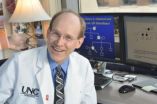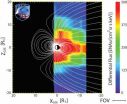(Press-News.org) A researcher at the National Institute of Standards and Technology (NIST) has invented a method of making high-temperature superconducting (HTS) cables that are thinner and more flexible than demonstration HTS cables now installed in the electric power grid while carrying the same or more current. The compact cables could be used in the electric grid as well as scientific and medical equipment and may enable HTS power transmission for military applications.
Described in a paper just published online,* the new method involves winding multiple HTS-coated conductors** around a multi-strand copper "former" or core. The superconducting layers are wound in spirals in alternating directions. One prototype cable is 6.5 millimeters (mm) in outer diameter and carries a current of 1,200 amperes; a second cable is 7.5 mm in diameter and carries a current as high as 2,800 amperes. They are roughly one-tenth the diameter of typical HTS cables used in the power grid. (Standard electrical transmission lines normally operate at currents below 1,000 amperes.)
HTS materials, which conduct electricity without resistance when cooled sufficiently (below 77 K, or minus 196 C/minus 321 F, for the new cables) with liquid nitrogen or helium gas, are used to boost efficiency in some power grids. The main innovation in the compact cables is the tolerance of newer HTS conductors to compressive strain that allows use of the unusually slender copper former, says developer Danko van der Laan, a University of Colorado scientist working at NIST.
"The knowledge I gained while working at NIST on electromechanical properties of high-temperature superconductors was very important for inventing the initial cable concept," van der Laan says. "For instance, my discovery that the conductor survives large compressive strains*** made me realize that wrapping the conductor around a small diameter former would most likely work."
Van der Laan and NIST colleagues demonstrated the feasibility of the new concept by making several cables and testing their performance. They used an HTS material with a critical current that is less sensitive to strain than some other materials. Although the prototype cables are wound by hand, several manufacturers say mass production is feasible.
NIST researchers are now developing prototype compact HTS cables for the military, which requires small size and light weight as well as flexibility to pull transmission lines through conduits with tight bends. Beside power transmission, the flexible cabling concept could be used for superconducting transformers, generators, and magnetic energy storage devices that require high-current windings. The compact cables also could be used in high-field magnets for fusion and for medical applications such as next-generation magnetic resonance imaging and proton cancer treatment systems.
INFORMATION:
The work was supported in part by the U.S. Department of Energy.
* D.C. van der Laan, X.F. Lu, and L.F. Goodrich. Compact GdBa2Cu3O7-?. coated conductor cables for electric power transmission and magnet applications. Superconductor Science & Technology. 24 042001, doi: 10.1088/0953-2048/24/4/042001.
** The superconducting compound used in the work is gadolinium-barium-copper-oxide, or GdBa2Cu3O7-?.
*** See the NIST Feb. 15, 2007, Tech Beat article "Strain Has Major Effect on High-Temp Superconductors," at www.nist.gov/public_affairs/techbeat/tb2007_0215.htm#htc.
Compact high-temperature superconducting cables demonstrated at NIST
2011-02-18
ELSE PRESS RELEASES FROM THIS DATE:
Promise of genomics research needs a realistic view
2011-02-18
CHAPEL HILL, N.C. - In the ten years since the human genetic code was mapped, expectations among scientists, health care industry, policy makers, and the public have remained high concerning the promise of genomics research for improving health.
But a new commentary by four internationally prominent genetic medicine and bioethics experts cautions against the dangers of inflated expectations – an unsustainable genomic bubble – and it offers ways to avoid it while still realizing "the true – and considerable – promise of the genomic revolution."
"This commentary is ...
Technology breakthrough fuels laptops and phones, recharges scientist's 60-year career
2011-02-18
EAST LANSING, Mich. — How does a scientist fuel his enthusiasm for chemistry after 60 years?
By discovering a new energy source, of course.
This week, SiGNa Chemistry Inc. unveiled its new hydrogen cartridges, which provide energy to fuel cells designed to recharge cell phones, laptops and GPS units. The green power source is geared toward outdoor enthusiasts as well as residents of the Third World, where electricity in homes is considered a luxury.
"SiGNa has created an inherently-safe solution to produce electric power, resulting in an eco-friendly and cost-effective ...
Asthma tied to bacterial communities in the airway
2011-02-18
Asthma may have a surprising relationship with the composition of the species of bacteria that inhabit bronchial airways, a finding that could suggest new treatment or even potential cures for the common inflammatory disease, according to a new UCSF-led study.
Using new detection methods, researchers learned that the diversity of microbes inside the respiratory tract is far vaster than previously suspected – creating a complex and inter-connected microbial neighborhood that appears to be associated with asthma, and akin to what has also been found in inflammatory bowel ...
Mayo researchers, Rochester educators, students to present at science conference
2011-02-18
ROCHESTER, Minn. -- America's largest general science conference will be the setting next week for seven presentations on how zebrafish changed the classroom in Rochester. Those presenting at the conference in Washington, D.C., include researchers from Mayo Clinic and Winona State University, educators from the Rochester school system, and several students.
"We started out trying to improve how science was taught. That led to adding curriculum beyond science, and resulted in improvement in testing and grade outcomes, and now to the experience of reporting all of it at ...
Inexpensive rinsing effective at reducing post-op infection following joint replacement surgery
2011-02-18
CHICAGO – A rinsing technique with betadine that costs just a little over one dollar per patient may significantly reduce the infection rate following total knee and hip joint replacement surgery according to a study by researchers at Rush University Medical Center.
The study, presented at the American Association of Orthopedic Surgeons 2011 Annual Meeting, found that a three minute diluted betadine lavage combined with painting of the skin with a 10% betadine solution prior to surgical closure nearly eliminated early deep post-operative infection.
Deep periprosthetic ...
Canadian brainpower at AAAS in Washington
2011-02-18
Washington (February 17) — Three leading Canadian language and speech experts will take centre stage in discussions on the latest developments in speech research at this year's annual meeting of the American Association for the Advancement of Science in Washington, D.C. (February 17-21).
Ellen Bialystok of York University has been a driving force in revealing the unique window that bilingualism opens on brain function. Her research disproves earlier claims of cognitive deficits among bilingual children, discovering, instead, that bilingual children and adults have distinct ...
ASTRO publishes palliative radiotherapy for bone metastases guideline
2011-02-18
The American Society for Radiation Oncology (ASTRO) Clinical Affairs and Quality Committee has developed a guideline for the use of radiation therapy in treating bone metastases. The guideline will be published in the International Journal of Radiation Oncology•Biology•Physics, an official journal of ASTRO.
Bone metastases are caused when a malignant tumor spreads to the bone. They can lead to debilitating effects including pain, fractures and paralysis due to spinal cord compression. The care of these patients requires collaboration between several types of cancer treatment ...
Catching space weather in the act
2011-02-18
Close to the globe, Earth's magnetic field wraps around the planet like a gigantic spherical web, curving in to touch Earth at the poles. But this isn't true as you get further from the planet. As you move to the high altitudes where satellites fly, nothing about that field is so simple. Instead, the large region enclosed by Earth's magnetic field, known as the magnetosphere, looks like a long, sideways jellyfish with its round bulb facing the sun and a long tail extending away from the sun.
In the center of that magnetic tail lies the plasma sheet. Here, strange things ...
NASA sees former Tropical Storm Carlos still a soaker in the Northern Territory
2011-02-18
Now a remnant low pressure area, former Tropical Storm Carlos continues to move southwest inland over Australia's Northern Territory and dump heavy amounts of rainfall. NASA's Aqua satellite saw some of the high thunderstorms within Carlos over land and extending north into the Timor Sea.
The Atmospheric Infrared Sounder (AIRS) instrument onboard NASA's Aqua satellite measures cloud-top, sea surface and land temperatures. Those are important factors in determining the strength and power of a tropical cyclone. Sea surface temperatures need to be at least as warm 26.6 ...
NASA infrared satellite data see an intensifying Tropical Storm Dianne
2011-02-18
Infrared satellite data from NASA's Aqua satellite reveal that Tropical Storm Dianne is getting organized off the coast of Western Australia today.
NASA's Atmospheric Infrared Sounder (AIRS) infrared imagery suggests that Dianne's center of circulation is consolidating and getting organized. There are bands of thunderstorms wrapping into the center of the storm, indicating strengthening is occurring. The AIRS instrument flies aboard NASA's Aqua satellite. The AIRS infrared image of Tropical Storm Dianne from Feb. 17 at 06:05 UTC (1:05 a.m. EST) showed a large area of ...




